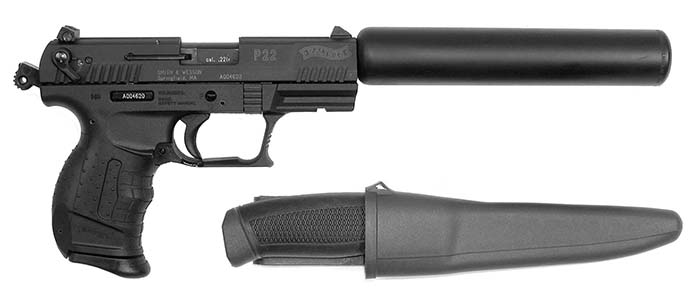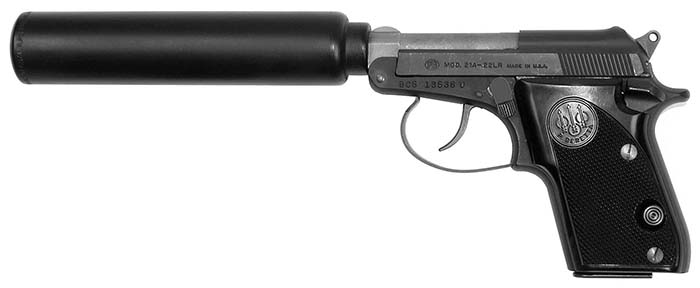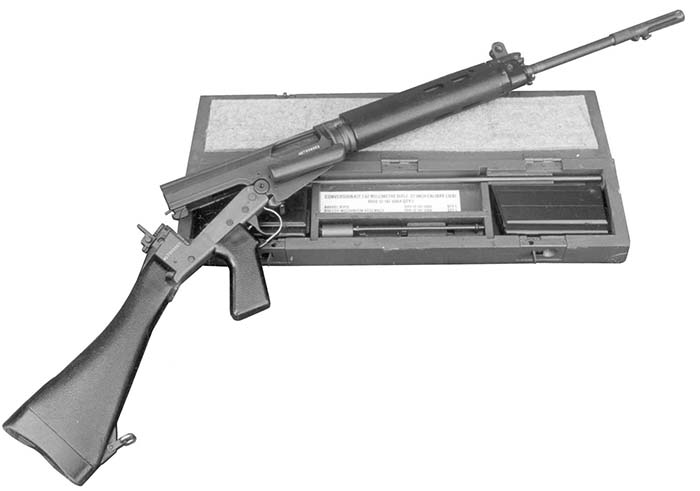Sound Technology Model M integrally suppressed pistol with 50,000+ rounds through it evaluated in this study.
by Al Paulson
Sound Technology’s integrally suppressed Ruger Mark II pistols have a long-standing reputation for excellent sound suppression, long service life, and exceptional accuracy. For example, one long-range fanatic I know mounted a 48-power rifle target scope on a Sound Tech suppressed KMK-10 pistol and shoots quarter-sized groups from a sandbag rest on a calm day at 200 yards using Ely TENEX ammunition. An animal-control professional who buys five integrally suppressed Sound Tech pistols a year finds that the Ruger Mark II pistol wears out before the Sound Tech suppressor (after approximately 200,000 rounds). This study provides a brief but detailed look at the performance of Sound Tech’s most popular silenced .22 pistols at the time of this writing – a combination of target, sporting, and pocket pistols featuring either integral suppressors or muzzle cans.
Integrally Suppressed Ruger Mark II Pistols
The flagship of the Sound Tech line is Mark White’s Model M integrally suppressed Ruger Mark II, which is typically based upon KMK-512 (stainless) model pistol. Those who would prefer a blued pistol usually have theirs built on a P-512 (the Ruger 22/45 with 5.5-inch blued bull barrel), that is 7 ounces lighter and about $50 cheaper than the KMK-512. Before I graduated to progressive multifocal eyeglasses, my pick of the litter was the variant evaluated in this study, which features a 1×9.5-inch suppressor tube. Now I prefer the Sound Tech variant with 1×8-inch tube, which is easier to shoot with progressive multifocals. While most of Sound Tech’s clients also prefer the 8-inch model, it is the longer suppressed variant that is truly the flagship of the Sound Tech line, so the 9.5-inch model is the subject of this study.
The suppressed pistol with 9.5-inch tube looks like an unmodified KMK-10 pistol, since the suppressor tube blends gracefully with the receiver and the muzzle cap is TIG-welded, ground, sanded, and carefully polished so there is virtually no evidence of a separate end cap seam nor are there assembly wrench holes to give the game away. From both visually stealthy and aesthetic points of view, this is a snazzy presentation.
How much bulk and weight does an integral suppressor add to an unmodified pistol? The KMK-512 features a 5.5-inch bull barrel, with an overall length of 9.75-inches and a weight of 42.0 ounces. The KMK-10 features a 10-inch bull barrel, with an overall length of 14-5/16 inches and a weight of 51 ounces. Sound Tech’s integrally suppressed pistols feature a barrel placed under tons of pressure to minimize barrel harmonics and maximize accuracy, special porting 3 inches from the breech – not to maximize sound suppression, but rather to maximize accuracy, and a baffle design that does not accumulate gunk as rapidly as some other designs. The variant with Model M suppressor with 9.5-inch tube is 15.0 inches in overall length, and it weighed 48 ounces new. That’s 6 ounces heavier than an unmodified KMK-512. Compared to an unmodified KMK-10, a new Model M with 9.5-inch tube is 3 ounces lighter and 11/16-inch longer. While the weight is quite manageable, the 9.5-inch tube is a lot of architecture to manage. Therefore, I’d recommend fitting the pistol with Hogue rubber grips with thumb rest to make the pistol a lot more comfortable to hold and fire.
I should note that after more than 50,000+ rounds have been fired though it, this pistol has gained an additional 0.7 ounce of accumulated lead that has plated the inside of the suppressor. (Loose lead dust can be shaken or flushed out, and disposed in an environmentally responsible manner.) The pistol is still a tack-driver, and it still provides excellent sound reduction, as Table 2 shows.
This accumulation of lead has implications for the safety of indoor ranges as suggested by unpublished Finnish academic research reported in Paulson (1996). Finnish research suggests several things about the risk of lead poisoning at indoor ranges. (1) Friction with the rifling in the bore and possibly interaction of hot combustion gases with the exposed lead at the rear of a lead bullet turn some lead into a vapor. (2) The lead vapor condenses into fine lead dust after it has left the muzzle. Airborne vapor and dust can be inhaled directly. This fine lead powder quickly settles on flat environmental surfaces. (3) If disturbed, the lead dust can be inhaled. (4) Inhaled lead vapor and dust will slowly poison the shooter. Lead poisoning – like radiation poisoning – is cumulative.
The Finns postulated that the lead vapor condenses out inside the suppressor as lead dust and that it also plates the internals and previously accumulated lead, if present. Since Mark White caters to animal-control professionals whose employees may shoot 100,000 rounds per year out of a suppressed .22 LR pistol, he’s had the opportunity to dissect his own and other integrally suppressed .22 Rugers after they’ve been retired. These dissections confirm the Finns’ contention that a significant amount of lead vapor is trapped inside a suppressor, thereby reducing the amount of lead vapor and dust discharged into the environment.
White’s S-baffle design is good at redirecting hot combustion gases into places inside the suppressor, where it condenses out and remains inside portions of the suppressor, where the accumulated lead has minimal effect on sound reduction, accuracy, or operational lifespan.
Furthermore, in a truly objective world, there is an argument to be made that the US Environmental Protection Agency should offer government grants to agencies, companies, and individuals with indoor shooting ranges for the purchase of sound suppressors both to reduce the risk of hearing damage, and to reduce the risk of heavy-metal poisoning from inhaled lead vapor and dust.
Sound Tech packs a lot of technology into a net gain of 6 ounces over the KMK-512. As White points out, “There are two ways to suppress the Ruger Mark II: integral suppressors and muzzle cans. The integral suppressors seem much simpler from the outside, but they are much more complex inside compared to muzzle cans. Integrally suppressed pistols are attractive because they have graceful lines and are capable of extraordinary accuracy if carefully designed and built. But there is no free lunch, as one writer says from time to time.
“From the end-user’s point of view, integrally suppressed pistols deliver less projectile velocity than a pistol with a muzzle can. This can be a good thing or a bad thing, depending upon which ammunition is used and the needs of the operator. Another negative with integrally suppressed Ruger pistols is that they need much more frequent cleaning than pistols using muzzle cans.”
“A good thing about integrally suppressed Ruger Mark IIs,” White continued, “is that integral suppressors are much more robust than pistols fitted with muzzle cans. The threaded interface between a muzzle can and a handgun is the weakest link in the system. A very hard blow to the front of the muzzle suppressor can bend the mount and cause misalignment of the baffles with the pistol’s bore.
“From the manufacturer’s perspective, integrally suppressed pistols are so much more expensive to build that most makers of premium suppressed pistols barely break even. Integrally suppressed Mark IIs are flagships of the designer’s art, not sources of income. Still, whether you are an end-user or a manufacturer, you gotta love ‘em. As someone once said, ‘Few firearms exhibit such a graceful marriage of form and function as the integrally silenced Ruger Mark II.’”
While Mark White and I prefer the visually stealthy integrally-silenced models just described, some collectors want their integrally-suppressed pistol to look like a gnarly silenced weapon rather than a nifty but otherwise unremarkable, unmodified target pistol. For these folks, White designed a “bulldog” variant of the silenced KM-512 with 1-3/8 by 6-3/4-inch tube that shouts, “silenced pistol!” to anyone who sees it. Called the M2 Model, the beefy bulldog variant evaluated in this study has an overall length of 12-3/8-inches and a weight of 47.2 ounces.
Performance of Sound Technology’s Model M with 1×9.5-inch tube and Model M2 with 1.38×9.5-inch integrally suppressed Ruger Mark IIs were tested with three kinds of Remington .22 Long Rifle ammunition: 40-grain RN high velocity (HV), 40-grain RN standard velocity, and 38-grain HP subsonic. Suppressed performance was compared to an unsuppressed Ruger KMK-512. All pistol and suppressor combinations were tested on the same day at temperatures raging from 52 to 54 degrees Fahrenheit. The speed of sound varied from 1,109 to 1,111 fps. An earlier test on the Model M suppressed pistol was conducted at 80 degrees, when the speed of sound was 1,139 fps. This study employed the testing regimen and equipment used by Paulson (1996) as amended by Paulson, Parker, and Kokalis (2002). Suppressed and unsuppressed sound pressure levels appear in Table 1. Net sound reductions appear in Table 2, and muzzle velocities appear in Table 3.
I had the opportunity to test the same Model M with 1×9.5-inch suppressor when it was relatively new (after 8,000+ rounds had been fired through it), and again more than four years later after 50,000+ rounds had been fired through it. I use the phrase “fairly new” with a hint of irony, since nice integrally suppressed pistols that I’ve studied over the years have demonstrated life spans varying from 10,000 rounds to 200,000 rounds. At the low end of that range, lead buildup resulting from poorly designed or executed barrel porting – frequently exacerbated by the design of structures immediately downstream of that porting – has been responsible for the low-end life spans.
As seen from the first batch of data listed in Table 1, the relatively new M2 system delivered mean (average) sound signatures of 114, 109 and 110 decibels with high velocity, standard velocity and subsonic ammunition, respectively. Compared to action noise of 109 decibels (measured as the sound of the bolt closing on an empty chamber, using the bolt-release lever), this is stellar performance. Sound Technology’s Model M integrally suppressed pistol is most accurate with standard velocity ammunition, and the sound signature equals the action noise with this ammunition. What more could you want?
Testing after another 42,000+ rounds had been fired through this system produced the second batch of Model M data in Table 1. These data show that the muzzle blast of the integrally suppressed pistol is within 3 dB of action noise with subsonic ammunition. Remember, this pistol already had 50,000+ rounds through it before this second batch of tests was conducted.
It is interesting that the larger diameter M2 1.38×6.75-inch bulldog variant was not as quiet as the Model M 1×9.5-inch flagship variant despite the fact that they have nearly identical volumes (9.3 versus 9.5 cubic inches, respectively). This confirms the old suppressor design rule of thumb that, “Given two suppressors of equal volume, the longer one (typically with more baffles) will be the quieter one.” This old theorem dates back to the days of simple symmetric baffles. Another factor is at work here, since White uses relatively few baffles. Sound Tech’s S-baffles are uniquely asymmetric, and they work more efficiently with higher gas pressures. Therefore, decreasing tube diameter actually improves their efficiency. If you absolutely lust after a gnarly, integrally suppressed Ruger Mark II that provides good sound suppression and outstanding accuracy, then Sound Tech’s Model M2 provides .177-caliber pellet-gun-level sound signatures with standard velocity and subsonic ammunition, and quite usable stealthiness with high velocity fodder.
For my own biases, however, I’d much prefer the graceful lines and stellar performance of Sound Tech’s Model M integrally silenced Mark II pistol.

Taking Stock
One of Sound Technology’s customers came up with a removable, non-attached buttstock that is 7 inches long and greatly extends the effective range of a suppressed Mark II pistol. He has graciously allowed Mark White to manufacture the stock for Sound Technology customers. The front of the stock features a channel that cups the rear of the pistol grip and is held in place by the thumb of the strong hand. The factory adjustable notch-type rear sight works remarkably well so close to the eye, but Brownell’s carries a replacement peep sight that works much better. This makes a dandy accessory for my suppressed kit gun. Two variants of the stock are available: bright stainless steel to match bright stainless suppressed pistols, and a chrome moly steel version finished in black powdercoat to match matte black suppressed pistols. The stainless stock weighs 10 ounces. I find it a most useful accessory in my survival kit, when kayaking or otherwise traveling in wild places.
Stalking the Stealthy Walther P-22
The appearance of the Walther P-22 has been nothing short of a sensation. The diminutive sibling of the 9x19mm Walther P-99, this compact .22 LR pistol retains its bigger brother’s manners and comportment. Two variants are available: one with a 3.5-inch barrel and one with a 5.0-inch barrel. The shorter P-22 is generally preferred for adding a sound suppressor, since it will keep all ammunition subsonic, even with the freebore boost typically generated by a sound suppressor (see Table 3). The remarkably thin barrel is held in tension by a barrel bushing, which is normally replaced by a threaded bushing when a sound suppressor is to be fitted.

Sound Technology’s Squelch sound suppressor is unusual in that its rear mount replaces the factory barrel bushing. No additional adapter is required. Not only is this a cheaper solution, it minimizes the risk of suppressor misalignment of the bore. “A Walther P-22 barrel adapter,” Mark White observed, “has two alignment surfaces and two sets of threads, each of which offers a chance for misalignment. Incorporating the adapter into the silencer is simpler, stronger, and less prone to problems.” To shoot the P-22 without the suppressor, simply unscrew the silencer and re-install the factory barrel bushing.
The Squelch model sound suppressor from Sound Technology comes in two basic variants. Both are fabricated from chrome moly steel and are finished in a nonreflective black powdercoat. The basic or standard Squelch measures (S-Can for short) has a diameter of 1.128 inches, a tube length of 5 inches, and a weight of about 8.7 ounces. The Super Squelch suppressor has a diameter of 1.38 inches, a tube length of 5 inches, and a weight of about 10 ounces. The bigger suppressor is quieter, but the smaller suppressor is more aesthetically pleasing. The smaller Squelch model was used for this evaluation of the Walther P-22. The Squelch siblings are designed as dry cans; the sound signatures and net sound reductions reported in Tables 1 and 2 were obtained with a dry can. That said, one could virtually eliminate first-round pop and lower the noise of subsequent shots by putting a small amount of red Jet Lube or a short squirt of WD-40 in the rear expansion chamber before making the cold shot of the day.
Tables 1 and 2 show excellent sound reduction for a dry muzzle can on a short-barreled pistol. The Squelch delivered 36-, 38-, and 39-decibel sound reductions with Remington high velocity, standard velocity, and subsonic ammunition, respectively. This is wet can performance out of a dry can. It is safe to say this is an impressive achievement. Furthermore, dry cans are a whole lot more fun to shoot than wet cans.
Contrary to some reports on the Internet about finicky reliability based upon ammunition type, this suppressed P-22 cycled with absolute reliability using all kinds of ammunition, keeping offhand hits in pop can bottoms during rapid-action drills. The increased backpressure generated by the sound suppressor may have contributed to this enhanced reliability.
Sound Technology’s Squelch silencer on the Walther P-22 with 3.5-inch barrel is a fun, sensual, stealthy combination.

Silencing the Beretta 21A Pocket Pistol
The 12.3-ounce Beretta Model 21A seems to be the most robust and reliable .22 LR pocket pistol suitable for suppressing. The Mossad (Israel’s CIA) and Israel’s sky marshals have used a longer-barreled version of the Model 21A for decades as their primary duty weapon, due to the round’s sound and penetration characteristics, as well as the ability to hide the tiny weapon in deep concealment.
Such short-barreled pistols as the Model 21A produce a much louder report and belch more carbon monoxide and unburned particulates in the flash than pistols with longer barrels (see Table 1). Sound Tech’s Squelch can for the Beretta is specially designed to work with this particular pistol once it has been fitted with an aftermarket barrel threaded 1/2×28 TPI. The beefy Beretta Squelch weighs 15.5 ounces, compared to the Model 21A’s weight of 12.6 ounces with threaded barrel. The Beretta Squelch has a tube length of 5.25 inches, an overall length of 5.38 inches, and a business-like girth of 1.128 inches. The Beretta Squelch drops the weapon’s gunshot noise down to airgun levels; the Crossman American Classic Model 1377 .177 caliber air pistol, for example, delivers a sound pressure level of 120-123 dB, depending upon the number of pumps. The Beretta Squelch provides excellent performance in a dry can when mounted on a 2.4 inch barrel.
So there it is, the Sound Tech .22 Pistol Sampler. There’s a terrific treat for nearly any taste. The only problem is that it’s hard to pick just one.
Literature Cited
Paulson, A.C. 1996. Silencer history and performance. Volume 1. Sporting and tactical silencers. Paladin Press, Boulder, CO. 424 pp.
Paulson, A.C, N.R. Parker, and P.G. Kokalis. 1996. Silencer history and performance. Volume 2. CQB, assault rifle, and sniper technology. Paladin Press, Boulder, CO. 429 pp.
Sources:
Sound Technology
Dept. SAR
P.O. Box 391
Pelham, AL 35124
Phone and fax 205-664-5860
Website: http://www.soundtechsilencers.com
| This article first appeared in Small Arms Review V7N11 (August 2004) |












